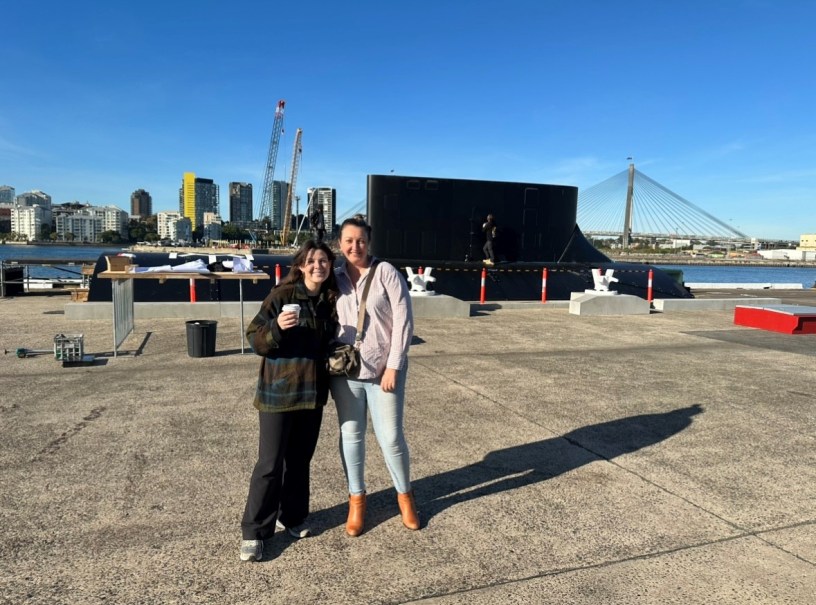Michelle Nagy thought she had her career all sorted. She was going to be a journalist. She even had work experience with the Hill Shire Times – her local paper in Castle Hill, NSW.
As part of that gig, she was asked to review The Matrix (filmed at Fox Studios in Sydney) and a whole new world of film opened for her.
“It was an amazing film, with an amazing script. Everything about it looked very different to anything else at the time. I loved it and it changed my world.”
Journalism was off the table and a career in film replaced it.
Fast forward 20 years and Nagy’s an art director, working alongside production designer Tim Ferrier, who was set decorator on The Matrix, on the crew of Paramount+’s highly-anticipated series NCIS: Sydney..
“When he started telling me these stories about his earlier career, I was just blown away at the synergy.”
But Nagy’s road to a head of department, running the art department on NCIS, was a twisting one, with a few speed humps along the way.
While studying journalism and media production at the University of Western Sydney, she got a runner job on Everything Goes – a 2004 short film directed by Andrew Kotatko.
“It had Hugo Weaving in it and I was driving Abby Cornish around. Colin Englert was the producer and I thought ‘This is amazing. My career is going to be amazing from now onwards.’”
But it wasn’t.
“Unfortunately I started really high and just as soon as I got into the industry itself, I didn’t realise the expectations. That it was going to be 50 hour + weeks and how hard it would be. There was a lot of segregation between men and women then [early 2000s]. It was really hard.
“I burnt out really quickly, left and didn’t go back for five years.”
After working in a book store, travelling to Hungary to spend time with her family and its history, and resuming writing, Nagy decided to have another go.
She returned to study – this time focusing on directing, screenwriting and producing at the International Film School in Sydney. Importantly, she also did a Certificate IV business course that was being offered by the government for free at the time.
“That really helped me with the freelancing side of things. I couldn’t work out how to balance freelancing gigs.”
She started work in broadcast operations at Foxtel then moved into advertising, producing TVCs while producing short films for directors she knew. She was establishing a strong CV.
But, despite the obvious transferable skills she had, there were not considered strong enough for long form.
“I had to start all over again. So, I got in as a production secretary – and I was very lucky to get in because it was still so competitive.”
She amassed amazing credits in production on a huge range of productions, from The Block to 60 Minutes and Diary of an Uber Driver. She thought she was on her way to being a producer.
Not so. COVID hit and she was forced to move home to live with her parents and reconsider her future yet again. This time, it led to the art department, as an art co-ordinator on Back to the Rafters with art director Anthea Hodge. She’d worked with Hodge previously on Diary of an Uber Driver.
Initially, she’d thought of the gig as a temporary way to earn money, and that she’d return to producing. But she found she loved working in the art department.
“It’s so much fun and it’s creative, and it’s just a wonderful environment to be in.”
Numerous art department jobs followed until she landed her first art director job on Queen of Oz with Ferrier.
“It was amazing to get given a seat at the big table to talk about creative vision and practical implementation.”
Next stop NCIS, leading and managing a full-time team of 30 plus a small army of casuals in set decoration, props, graphics, construction, armoury and cars – whatever is required.
“The main aesthetic vision comes from the production designer, but then the art director has got to make it all land on the day.”
A huge gig which requires incredible resilience – and a plan for support while it plays out. Nagy advocates business and career mentoring and, most importantly, something for your health.
“I think it’s important that you carve out some time for that. Emotionally it’s really a tricky career, because the hours [in production mean] that you work and that you sleep, and then six months later you get popped out at the other end and you hope you’re still okay.”
Denise Eriksen is co-founder (with Esther Coleman Hawkins) of Media Mentors Australia.
The company has recently opened applications for management and leadership training for early career HODs or 2ICs ready to take the next step in their careers.


